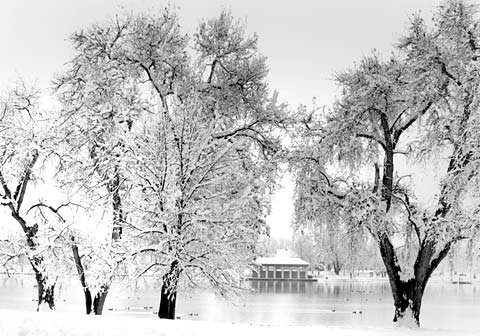West: Alameda to Louisiana, Lincoln to Downing
East: Alameda to Louisiana, Marion to University
History
| “30 acres of bare land, lying above the city ditch, with no tree or even shrub upon it…when nothing resembling a park can be made in the next 10 years” What a difference 100 years makes! It is hard to believe that one of Denver’s most popular parks, Washington Park, was met with such skepticism from The Denver Eye, at the turn of the 20th century!
Originally part of the town of South Denver, Smith’s Lake was eyed by Mayor Thomas S. McMurray as the ideal location for a new park. He purchased as much land as he could and then began proceedings to condemn additional property, reaching a total of 160 acres by the time all of the legal wrangling was finished in 1899. Designed by Reinhardt Schuetze (who also designed Platt Park), the first superintendent of the park was John B. Lang, who transplanted trees and shrubs from the mountains to landscape the area. By 1901, streetcar lines were expanding heading south on Franklin from Alameda, with one branch heading down South Gaylord to Louisiana. With the increase in accessibility came the first interest in building in Washington Park. Joseph Sterling’s park front home was built in 1906 and Washington Park Place was platted by the Park Place Land Company in 1907. The extensive landscaping at the park required a great deal of water, and Smith’s Lake came in handy. Grasmere Lake was also added at this time for additional water supplies. The first bathing beach at Smith’s Lake opened in 1911, and prior to being integrated in 1914, the lake was actually divided off by rope to keep the men and women apart! J.J.B. Benedict designed the boathouse and pavilion to the south of the lake, which were completed in 1913. Between 1920 and 1930 the population of Washington Park increased by 75 percent and brick bungalows popped up everywhere (a result of 1886 ordinance barring frame construction). The fire station, at 1540 East Virginia (where it continues to operate in a newer building today), was built in 1924. South Gaylord Street was zoned for business at its initial zoning in 1925 creating a thriving shopping area where local residents could find anything they needed from a haircut to a night out at the movies. During this time even Molly Brown was a part of Washington Park’s history. She is responsible for the relocation of Eugene Field’s house to the park in 1930 following his death. It had been the smallest library branch in Denver and remained open in that capacity until 1970. A former editor of the Denver Tribune, Field’s house was designated a Denver Landmark in 1970 and added to the National Register of Historic Places in 1979. Smith’s Ditch, which is 27.25 miles long, was originally responsible for supplying water throughout the city. Today, the only stretch that is still visible borders Washington Park from Virginia to Louisiana Avenues. It was designated a National Historic Landmark in 1977. Today, Washington Park is arguably the most popular and most loved park in Denver. The flower gardens are spectacular and feature over 62 varieties of annuals. No matter what the weather you always see someone taking advantage of the beauty of the park, a bare piece of land no more! |

“Boat House” Washington Park – Photo by Gifford Ewing
Discover Washington Park Architecture
Read Sonja’s review of Phil Goodstein’s book, “The Haunts of Washington Park”
